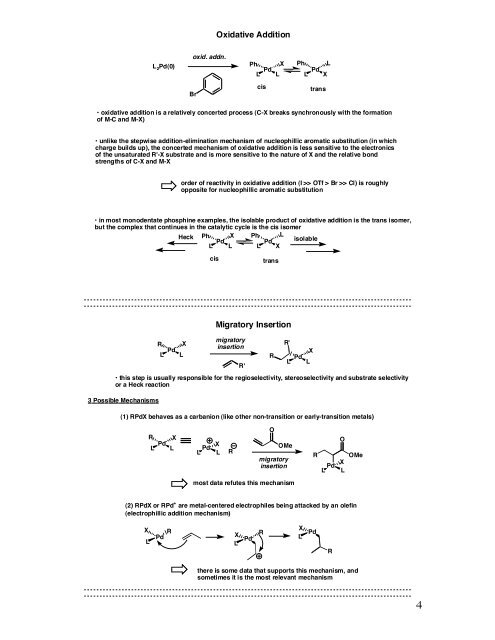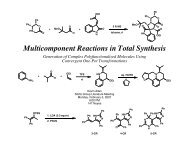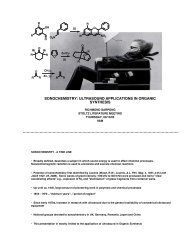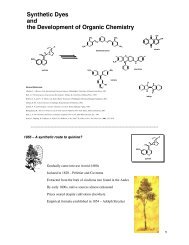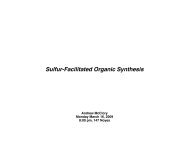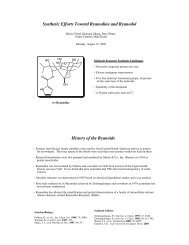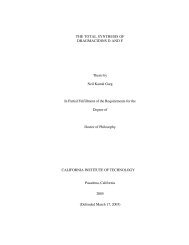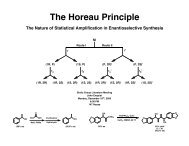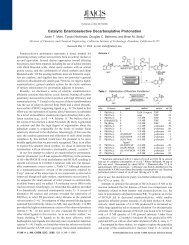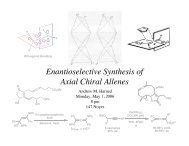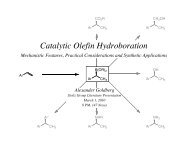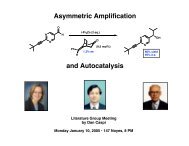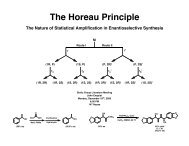The Heck Reaction: Mechanistic Insight into a ... - The Stoltz Group
The Heck Reaction: Mechanistic Insight into a ... - The Stoltz Group
The Heck Reaction: Mechanistic Insight into a ... - The Stoltz Group
You also want an ePaper? Increase the reach of your titles
YUMPU automatically turns print PDFs into web optimized ePapers that Google loves.
Oxidative Addition<br />
L 2 Pd(0)<br />
oxid. addn.<br />
Ph<br />
L<br />
Pd<br />
L<br />
X<br />
Ph<br />
L<br />
Pd<br />
X<br />
L<br />
Br<br />
cis<br />
trans<br />
• oxidative addition is a relatively concerted process (C-X breaks synchronously with the formation<br />
of M-C and M-X)<br />
• unlike the stepwise addition-elimination mechanism of nucleophillic aromatic substitution (in which<br />
charge builds up), the concerted mechanism of oxidative addition is less sensitive to the electronics<br />
of the unsaturated R'-X substrate and is more sensitive to the nature of X and the relative bond<br />
strengths of C-X and M-X<br />
order of reactivity in oxidative addition (I >> OTf > Br >> Cl) is roughly<br />
opposite for nucleophillic aromatic substitution<br />
• in most monodentate phosphine examples, the isolable product of oxidative addition is the trans isomer,<br />
but the complex that continues in the catalytic cycle is the cis isomer<br />
<strong>Heck</strong> Ph X Ph L<br />
Pd<br />
Pd<br />
isolable<br />
L L L X<br />
cis<br />
trans<br />
R X<br />
L<br />
Pd<br />
L<br />
Migratory Insertion<br />
migratory<br />
insertion<br />
R'<br />
R<br />
R'<br />
L<br />
Pd<br />
X<br />
L<br />
• this step is usually responsible for the regioselectivity, stereoselectivity and substrate selectivity<br />
or a <strong>Heck</strong> reaction<br />
3 Possible Mechanisms<br />
(1) RPdX behaves as a carbanion (like other non-transition or early-transition metals)<br />
R<br />
L<br />
Pd<br />
L<br />
X<br />
Pd<br />
L<br />
X<br />
L<br />
R<br />
O<br />
OMe<br />
migratory<br />
insertion<br />
R<br />
Pd<br />
L<br />
O<br />
X<br />
L<br />
OMe<br />
most data refutes this mechanism<br />
(2) RPdX or RPd + are metal-centered electrophiles being attacked by an olefin<br />
(electrophillic addition mechanism)<br />
X<br />
L<br />
R<br />
Pd<br />
X<br />
L<br />
Pd<br />
R<br />
X<br />
L<br />
Pd<br />
R<br />
there is some data that supports this mechanism, and<br />
sometimes it is the most relevant mechanism<br />
4


